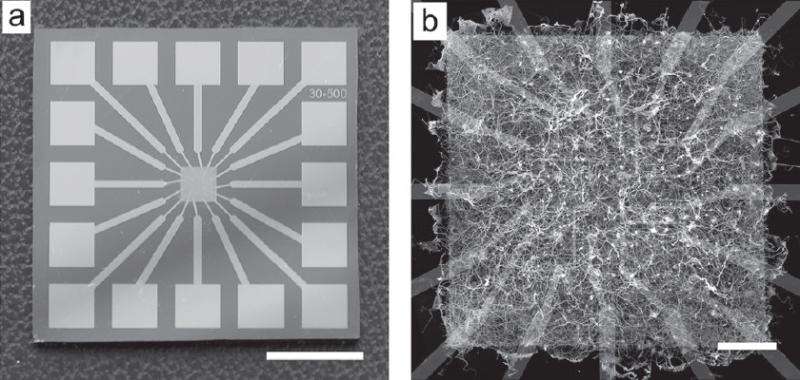May 13, 2015 feature
Scientists develop atomic-scale hardware to implement natural computing

(Phys.org)—Despite the many great achievements of computers, no man-made computer can learn from its environment, adapt to its surroundings, spontaneously self-organize, and solve complex problems that require these abilities as well as a biological brain. These abilities arise from the fact that the brain is a complex system capable of emergent behavior, meaning that the system involves interactions between many units resulting in macroscale behavior that cannot be attributed to any individual unit.
Unfortunately, conventional fabrication methods used for today's computers cannot be used to realize complex systems to their full potential due to scaling limits—the methods simply cannot make small enough interconnected units.
Now in a new paper published in Nanotechnology, researchers at UCLA and the National Institute for Materials Science in Japan have developed a method to fabricate a self-organized complex device called an atomic switch network that is in many ways similar to a brain or other natural or cognitive computing device.
"Complex phenomena and self-organization—though ubiquitous in nature, social behavior, and the economy—have never been successfully used in conventional computers for prediction and modelling," James Gimzewski, Chemistry Professor at UCLA, told Phys.org. "The device we have created is capable of rapidly generating self-organization in a small chip with high speed. Furthermore, it bypasses the issue of exponential machine complexity required as a function of problem complexity as in today's computers. Our first steps form the basis for a new type of computation that is urgently needed in our ever increasingly connected world."

As the researchers explain, an atomic switch is a nanoscale device that exhibits memristive resistance, meaning that it adjusts its resistance to an applied current or voltage based on its memory of previous encounters. This trait is essential for complex systems because it underlies the ability to learn, interact with the environment, and address problems in which data is constantly changing or incomplete.
Although some natural computing devices use natural materials, the atomic switch network developed here is made entirely of inorganic materials. Lithographically patterned copper posts form a "patterned seed network," on top of which silver nanowires are grown. The end result is a network of silver sulfide switches and silver nanowires that connect the switches.
Experiments demonstrated that the atomic switch network exhibits emergent behavior, in which interactions between the individual atomic switches lead to patterns of electrical activity that cannot be attributed to any individual switch, but only to the network as a whole. The atomic switch network also has an intrinsic capacity for adaptation, since the silver nanowire connections are constantly reconfiguring themselves and the switches are constantly forming and dissolving in different locations in the network.
These traits are very different from those of conventional computers and could be used to solve unique sets of complex problems. The researchers see particular applications in the area of reservoir computing, which has the potential to process information at very high rates.
"Potential applications include running multiple simulations of financial markets, recognition of information in error-prone and noisy data, such as vision and speech, all the way to autonomous navigation in changing environments, such as after earthquakes or disasters," Gimzewski said. "Finally, reservoir computing has a role to play in medicine in the cognitive and neurosciences."
The researchers hope that the new fabrication strategy of seed-directed growth used here will provide a novel hardware platform for reservoir computing and other types of natural computing based on complex systems.
"We plan to move towards a hybrid morphic system using the best of conventional computation with our brain-like device capabilities, and to develop a new form of programming that relies on distributed memory and synaptic networks," Gimzewski said. "This would be a radical step in the real development of AI."
More information: E. C. Demis, et al. "Atomic switch networks—nanoarchitectonic design of a complex system for natural computing." Nanotechnology. DOI: 10.1088/0957-4484/26/20/204003
Journal information: Nanotechnology
© 2015 Phys.org



















